Harvey Kelly turns his eye to the Champions League Quarter Final first leg clash between PSG and Barcelona, and what we can expect from the game at the Camp Nou.
Barcelona threw a slight surprise with David Villa on the right of the attacking trident, and with Pedro struggling with a calf injury, Sanchez was the left-forward, with Messi in the centre. The rest of the team was as expected: a midfield three of Iniesta, Xavi and Busquets; Alves, Mascherano, Pique and Jordi Alba in defence.
Paris Saint-Germain played 4-4-2 with Ibrahimovic and Lavezzi up front, a midfield four of Pastore, Matuidi, Lucas Moura, and Beckham in place of Verratti, with a defence of Maxwell, Thiago Silva, Alex, and Jallet.
Without the ball PSG played as one might expect, two narrow banks of four defending very deep, and not pressing until the midfield four were engaged.
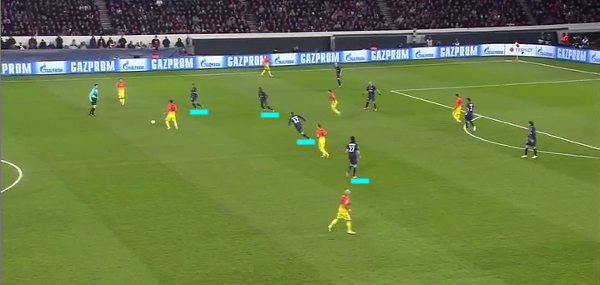
PSG’s first half of defending deep with a narrow midfield four
“I am very happy with his game. He has the ability to play the ball forward, to change the game.” – Ancelotti on Beckham
The midfield quartet did their job well and Barcelona weren’t able to play through them (it took Barcelona until the 17th minute to create a chance, a curling shot from the edge of the area from Iniesta). Throughout, the midfield looked extremely solid – the two flair players, Pastore and Lucas Moura, were generally very disciplined, even if the opening goal came from those two allowing Messi to run unchecked into space.
Thankfully for Ancelotti, the inclusion of David Beckham didn’t backfire, his reasoning being that a midfield of Lucas (20), Matuidi (25), Verratti (20), and Pastore (23) was going to be too young and inexperienced, thus Beckham would add some much-needed Champions League nous, and it could be said to have broadly worked. Beckham’s performance in his second start for PSG was as his first against Saint-Etienne in March: his positioning was good, he kept possession, and although in the first half he hit some nice long passes down the right to Lucas Moura, it must be noted that he doesn’t contribute much to the forward play.
In possession the Parisian midfield four had a very uneven feel about it: on the left Pastore was tucked-in almost as a central midfielder, while Lucas was far more energetic down the right flank. Pastore’s reluctance to get forward could be due to Ancelotti not wanting to leave PSG open to the counter-attack, but with Beckham providing cover in a very deep regista role this seems unlikely – Pastore has been disappointingly inconsistent since joining from Palermo and did nothing to dissipate the impression that he’s loitering on the periphery of games.
PSG aimed to defend deep, frustrate Barcelona, and then counter quickly – often with long passes to Ibrahimovic or Moura down the right, and look for the ball to be held up until others could join the attack. Although Ibra played well, oddly his touch and technique in the penalty box let him down on a couple of occasions. In the last rather frantic ten minutes, a long-ball game to Ibrahimovic as a target-man actually worked well for PSG, and they might try more longer passes in the return leg.
Barcelona overload the left, and attack down the right
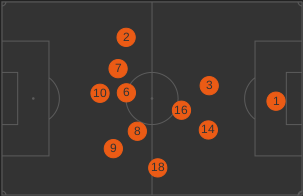 With Alexis Sanchez as the left-winger, Messi as the false-nine, and David Villa starting on the right, but spending much of the game in a centre-forward position, the Barcelona front line had a lopsided look about it. This was replicated in midfield with Xavi stationing himself in the centre of the pitch, with Iniesta to his left, and Busquets behind. The diagram is taken from WhoScored; the Barcelona players’ average positions from the game last Tuesday.
With Alexis Sanchez as the left-winger, Messi as the false-nine, and David Villa starting on the right, but spending much of the game in a centre-forward position, the Barcelona front line had a lopsided look about it. This was replicated in midfield with Xavi stationing himself in the centre of the pitch, with Iniesta to his left, and Busquets behind. The diagram is taken from WhoScored; the Barcelona players’ average positions from the game last Tuesday.
Xavi (#6) is the most right-sided of the three midfielders (#16 Busquets and #8 Iniesta are the other two).
Obviously this deliberate preference for one flank had repercussions for the full-backs. Jordi Alba and Dani Alves were both pushing high up the pitch, but one of them was in acres of space – Messi was also often drifting over to the right-hand side away from the congestion on the left.
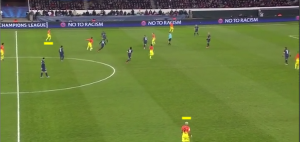
Alves’ space
The fullbacks are tagged with the yellow band in the image above, and it was common to see Alves in such space on the right: with PSG having to defend so narrowly to stop Barcelona playing through them, they had to surrender at least one flank, and this often led to Alves charging down the right, completely unopposed, until being checked by the PSG left-back Maxwell. On the left, Alba, Iniesta and Sanchez, looked to overwork the impetuous Jallet, who’s prone to making mistakes under pressure.
With both Barca fullbacks pushing so far up the flanks (if you go back to the diagram above, you’ll see that Alves was really playing as a right-winger, albeit one with defensive responsibilities) potentially this could have led to a dangerous two-versus-two at the back with Mascherano and Pique left to handle Ibrahimovic and Lavezzi by themselves. This meant they needed cover from Busquets reprising a role he’s played from time to time: much more conservative in his positioning than normal, Busquets was often dropping back between Pique and Mascherano as a third centre-back, and giving Barcelona the extra man against Ibrahimovic and Lavezzi.
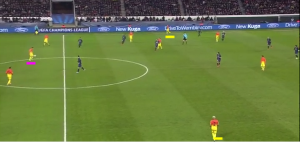
Busquets (pink) very deep as a centre-back, with fullbacks (yellow)
Against sides that play only one striker there’s no need for Busquets to drop back like this, but with both their fullbacks pushing up and facing a 4-4-2, the need for an extra man in defence meant that Busquets had a quiet game – and in the second half, when Alba wasn’t pushing up on the left flank as he had in the first, Busquets was content to play his defensive-midfield role, rarely looking to join any attacking play.
Second half
At the start of the second half, with Messi substituted for Fabregas due to a hamstring worry, Paris Saint-Germain started pressing much further up the pitch combined with a high line, which gave them a completely different defensive outlook from the first half.
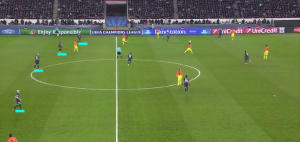
PSG’s second-half switch: high line and energetic pressing
Not being able to build from the back knocked Barcelona out of their stride, and yet, roughly ten minutes later PSG reverted to their first half plan of defending very deep, and Barcelona regained control. It would be interesting to see if Ancelotti is brave enough to be more aggressive with his defensive options in the return leg.
In the 66th minute Menez came on for Lavezzi, and PSG were briefly 4-4-1-1, with Menez behind Ibrahimovic looking to move across the pitch horizontally, but this left Ibrahimovic a little isolated, and in the 75th minute Ancelotti brought on Gameiro for Pastore, with Menez moving to left midfield and Gameiro playing off Ibrahimovic, reverting back to their 4-4-2. In the middle of those more tactical substitutions, Ancelotti took off a visibly tired Beckham for Verratti.
For most of the second half, with the exception of the ten-minute spell of aggressive pressing from PSG, Barcelona were playing almost on autopilot; large periods of possession without creating too many opportunities (although Sanchez should have done better with the two chances he had), against the two banks of four defending deep. With Barcelona tiring it was only in the last ten minutes, when PSG became a little desperate and started hitting long balls to Ibrahimovic, that the momentum turned towards the home side. The frantic finale saw Ibrahimovic’s offside goal allowed to stand, Sirigu giving away a penalty, and Matuidi scoring in the 94th minute with a deflected shot. For all Ancelotti’s careful planning, and then tweaking of that plan throughout the game, luck played the decisive role.
Injuries and suspensions
Matuidi’s suspension leaves an enormous hole in the PSG midfield. It would be too risky to field two ball-players in the central area (Verratti and Beckham), so with Thiago Motta seemingly still suffering with a groin problem, we could see Clement Chantome partnering either Verratti or Beckham – and if Beckham got the nod in the first game, he might be pencilled-in to start at Camp Nou. In central defence Ancelotti has more worries, with both Alex (thigh) and Thiago Silva (knee) struggling for fitness, so expect Mamadou Sakho to return to the starting lineup.
With Mascherano’s injury ruling him out for six weeks, Barcelona also have a serious problem at centre-back, and none of the options for a partner to Pique look too convincing: Carlos Puyol is still recovering from knee surgery; Eric Abidal, a fullback by trade, is feeling his way back from last year’s liver transplant (he played the last 20 minutes against Mallorca at the weekend); Adriano Correira (another fullback) is 50/50 to be fit in time; Alex Song has looked awful when played at centre-back; and young Marc Bartra, the substitute for Mascherano in Paris, started against Mallorca, but is very inexperienced.
A compromise might be to drop Busquets into central defence (where he has played before) and bring Alex Song into the defensive midfield role – but Busquets’ metronomic passing and positional sense would certainly be missed in midfield. If Abidal has come through his substitute appearance against Mallorca on Saturday unscathed, then the 33 year-old might in line for a dramatic return to the starting lineup.
Messi missed Barca’s game against Mallorca at the weekend, and it’s unclear whether he will back in time to face PSG. Consider, Messi has scored 43 goals this season. Until last weekend, David Villa had the second-highest goal tally for Barcelona, and he’s scored 8. To some extent, this can be explained by Barcelona’s tendency to maximise Messi’s effectiveness in his false-nine position (Thore Haugstad has written about this and what Barcelona expect from their wide players), but although this perhaps explains the lack of goals from his team-mates, nothing can really explain Messi’s goal rate – 212 goals in 243 appearances for Barcelona – add in his assists and his role in Barca’s possession play, and it’s clear that if he’s missing, like the Spanish national team at times, Barcelona might have trouble finding the net. Or so everyone thought. On Saturday, without Messi, Barcelona destroyed Mallorca 5-0 with Fabregas outstanding in the false-nine role netting a hat-trick (and providing both assists for Sanchez’s brace) to take him up to 9 goals for the season. If Messi is out, then Barcelona are as prepared for his absence as any side could be.
“It is impossible to not see it was offside by two metres” – Dani Alves, on Ibrahimovic’s equaliser.
Playing a high defensive line and using the offside law has become as synonymous with Barcelona as their possession football, and the two are linked: a high line makes the pitch smaller for their opponents, and constant pressing in a small playing area with an aggressive offside trap is a highly effective means of winning possession back, and everyone knows how highly Barcelona value possession.
This is so well-drilled, and the Barcelona defenders so aware, that even in the most pressured moments they’re catching players offside. The image below is from the 93rd minute when mental and physical fatigue were at their worst.
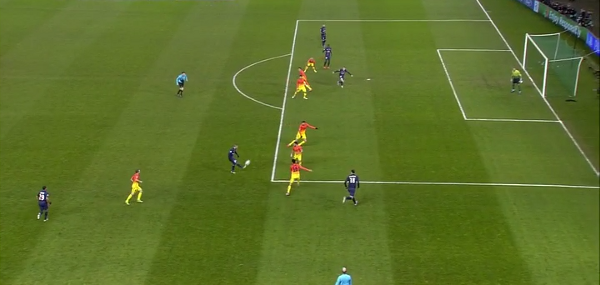
93rd minute – a perfect defensive line
Note in the image above how some of the Barcelona players’ momentum is going towards the goal, but all are maintaining the line perfectly. Their offside trap was impressive all night and it was the linesman at fault when PSG equalised, with Ibrahimovic clearly offside.
Playing in front of Barcelona’s defence is often fruitless, their pressing, high line, and well-drilled offside trap wins possession for their creative players. They can look vulnerable when they’re attacked at speed; either with a ball over the top or down the flanks.
The offside rule dominates all of Barcelona’s defensive thinking; they play a very high line when defending free-kicks, which means they don’t have to compete often in the air, but there’s one area of the game where their lack of height is a real factor, but they still use the offside rule: defending corners.
Barcelona defending corners, or, How to Score against the Best Team in the World
As Barcelona are such a small team – on Tuesday against PSG, only Busquets and Pique were over 5′ 9″ (174cm) – it’s interesting to see how they defend corners, and in the first leg it looked like a corner was going to be the way PSG could get a goal (until the linesman broke Barcelona’s perfect offside trap for them).
This is how Barcelona defend zonally, and it’s important to note they line-up this way irrespective of what their opponent does (image right).
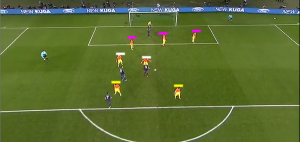
Zonal marking
As Pique is the best header of the ball, and the tallest in the team, his position is crucial and he guards the central 6-yard area. He and two others (marked with pink) guard the 6-yard box zonally, from left-to-right that’s Sanchez, Pique and Alba, notice that Barcelona do not put any defenders on the posts.
Two players have responsibility for the area from the penalty spot to the 6-yard line, Alves on the left and Busquets, the second-tallest of the side, on the spot (marked with white). If the opposition pack the 6-yard box, the pink and white zones move closer to the goal-line, but the zonal defence is set up the same way.
Further away from the goal Barca have Mascherano and Xavi (marked with yellow). These two players man-mark, but the players they man-mark can differ from corner to corner, as their job is pick up those attacking the ball from deep and stick with them as they enter the penalty box. If the opposition puts more players in the penalty area then Xavi will drop back towards to the goal and mark zonally alongside Alves and Busquets in the ‘white zone’.
In the image below, Beckham is just about to take the corner:
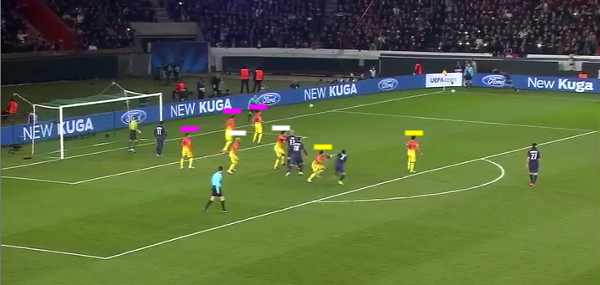
The three in the ‘pink zone’ and two in the ‘white zone’ hold their positions, guarding their assigned areas, whereas Mascherano (a ‘yellow man-marker’) is tracking the run of Thiago Silva coming from deep, and Xavi is left without a marking role as Pastore (#27) isn’t looking to attack the corner – Xavi’s responsibility becomes closing down and blocking any shots if the ball is cleared.
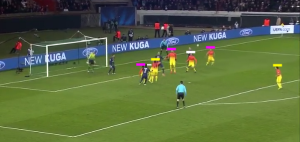
Lavezzi set up for a flag
Alex jumps for the ball, getting the better of Alves, who is obscured in the image by Mascherano (#14) in the centre of the image, but the ball is headed wide for a goal kick. What happens if the header is on target? Then Lavezzi, standing in the 6-yard box, would be flagged offside (only with a header to the far right of Valdes could Lavezzi be deemed not to be interfering with play).
This is why Barcelona don’t put anyone on the posts. Any knockdown or flick-on and with a defender on a post an opposing player in the six-yard area would be onside; additionally, not having anyone on the posts allows Barcelona to push up very quickly, again catching opposition players offside.
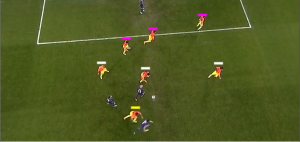
Xavi joins the ‘white zone’
If the corner is from the left (Barcelona’s right), then the defensive duties are mirrored: Alba takes the near-6-yard, Sanchez/Fabregas the far-6-yard, Busquets the penalty spot, Alves behind Busquets, Mascherano man-marking a player attacking from deep, and Xavi either the near-penalty-spot zone (image right) or tracking a runner.
Now only Mascherano is man-marking with Xavi marking zonally the near-penalty-spot. Mascherano tracks the runner, again it’s Thiago Silva, this time to the near post:

Good delivery crucial
Other than Silva, the only PSG players in the Barcelona penalty box are Gameiro in the 6-yard box, Ibrahimovic and Alex. That’s the 6′ 5″ Zlatan Ibrahimovic in 5′ 8″ Dani Alves’ ‘white zone’, and the ball is being played into the near-post area which Jordi Alba and Xavi (both 5′ 7″) have responsibility for.
Barcelona will defend corners this way on Wednesday, and PSG have to make sure they don’t waste their opportunities (it’s unlikely they will get many), but the more one looks at the image above, the more appealing a good delivery to the near-post becomes.
Conclusion
Barcelona aren’t going to get outplayed at home at Camp Nou, and Paris Saint-Germain have an almost impossible task: to go to Barcelona and get a win. The heading ‘How to Beat the Best Team in the World’ is obviously slightly tongue-in-cheek, but there are some key factors to look out for:
* Due to a high level of organisation and long periods of ball possession, Barcelona don’t concede many corners, so good delivery will be crucial to take advantage of limited opportunities.
* When PSG attack they will look to use Ibrahimovic’s height and strength with long passes out of defence from Beckham or Verratti, with the Swede holding the ball up and bringing Lavezzi into the game.
* In Paris, at the start of the second half, PSG pressed more aggressively and held a high line which unsettled Barcelona – will Ancelotti play this tactic for a longer period now this is a must-win game?
